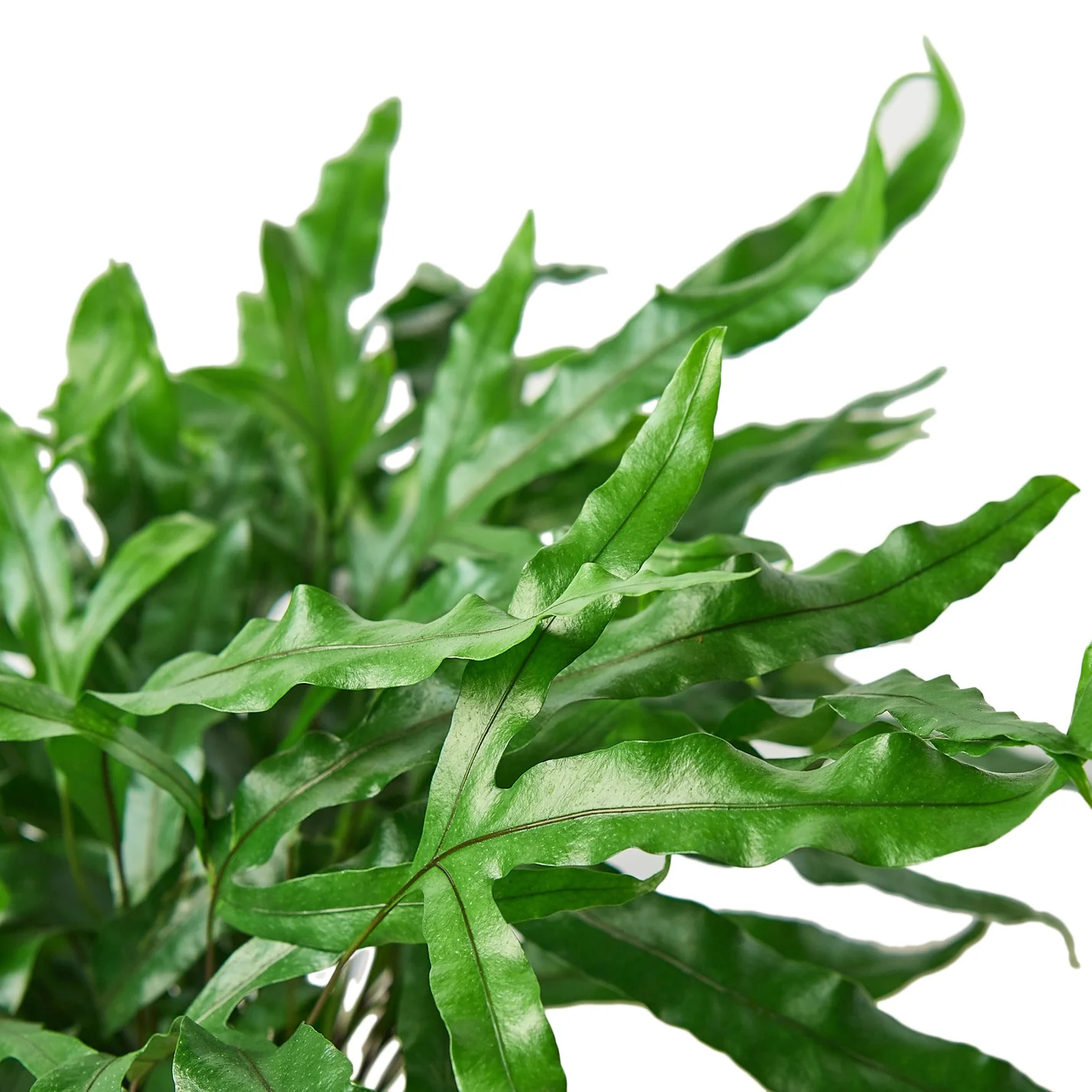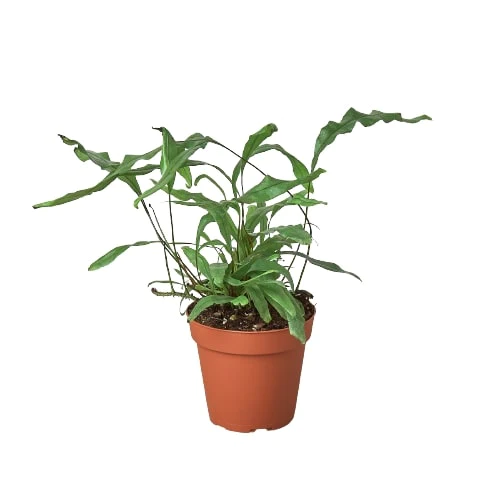HousePlantJoy is supported by our audience. When you purchase through one of our links, we may earn a small affiliate commission. As an Amazon Associate I earn from qualifying purchases. Your cost is not affected.
==================
You know that feeling of excitement when you discover a new plant, and it’s love at first sight? That’s the charm of the Kangaroo Paw Fern houseplant! Imagine first looking at its soft, emerald-green fronds resembling kangaroo paws. It’s easy to see why it’s a big hit among plant lovers. But the Kangaroo Fern is not just about good looks. It’s one sturdy trooper that can handle various indoor conditions, making it a joy to care for.
Picture this. You wake up in the morning. The sunlight streams in. And there’s the Kangaroo Fern perched on your window sill. Its fronds sway as if waving you a ‘good morning.’ Sounds lovely, right? That’s the green cheer. This excellent houseplant brings to your living spaces.
So, you’re wondering about the Kangaroo Paw Fern houseplant and its unique features. The Kangaroo’s foot plant gets its quirky name from the shape of its fronds, which have a pattern that looks similar to a kangaroo’s paw. And that’s not all – this attractive houseplant is also an excellent air purifier. That means it’s not just a pretty face; it’s working hard to clean the air you breathe too!
In the following sections, we will look into all the ins and outs of caring for this beautiful plant. We’ll cover everything you need to know to ensure your Kangaroo Fern thrives in its new home.
Join us on this green journey. Let’s find out why the Kangaroo Paw Fern houseplant is a good spot in your indoor space. Stay tuned, and let’s make our indoor spaces a bit greener, one Kangaroo Fern at a time! Enjoy reading!
Origin of the Kangaroo Paw Fern Houseplant
The Kangaroo Paw Fern houseplant, also known as Microsorum diversifolium, is a delightful addition to any home garden. Did you know that it hails from the stunning landscapes of Australia? That’s right; this beautiful plant is an Aussie native, making it a perfect choice for nature lovers looking for pet-friendly plants. It originates from the same land as kangaroos and koalas.
You’d spot this gem sprawling across damp forest floors or perched on tree trunks in its natural environment. The Kangaroo Paw Fern houseplant is a special kind called an ‘epiphytic’ fern. Now, that’s a fancy word. But it means that this plant can happily grow on other plants without causing them any harm.
Let’s reflect on its forest origins, particularly in the context of toxic plants. Unsurprisingly, our Kangaroo Fern enjoys a bit of humidity and indirect light. Don’t worry. We’ll investigate how to recreate these conditions for your Kangaroo Fern at home, considering the potential presence of toxic plants. But for now, let’s appreciate some of the Australian wilderness right in our living spaces!
Understanding our plant’s backstory not only helps us provide what it needs. But it also makes our bonding with it even more special. Plus, it’s fun trivia to share with friends and fellow plant lovers! Please stick with us as we learn about the Kangaroo Paw Fern houseplant.
Growing the Kangaroo Paw Fern Houseplant
Creating your little slice of nature inside your home is an exciting adventure. And the Kangaroo Paw Fern houseplant makes it all the more rewarding. Let’s dive into how you can grow and nurture this charming Aussie in your indoor space!
-
Finding the Perfect Spot
You’ll need to find the right spot for your Kangaroo Fern. Remember. It loves indirect light, just like the filtered sunlight it would get in an Australian forest. A north or east-facing window would be perfect. But don’t worry if you don’t have one. This fern is adaptable and can manage in lower light conditions too.
-
Maintaining the Ideal Temperature and Humidity
Your Kangaroo Paw Fern houseplant loves to be warm and cozy. It thrives best in temperatures between 60-75 degrees Fahrenheit. As for humidity, the more, the merrier. A humidifier, a pebble tray with water, or even a regular misting can help keep your fern happy. If your home is arid, try grouping it with other plants. Plants are social creatures, you know! They can create their mini-humid climate when placed together.
-
Watering and Feeding Needs
When it comes to watering, the Kangaroo Fern likes its soil to be moist but not waterlogged. A good rule of thumb is to water it when the top inch of the soil feels dry to the touch.
Let’s discuss feeding. A gentle dose of houseplant fertilizer during the growing season is enough. This is from spring to early fall. It will keep your Kangaroo Paw Fern houseplant healthy and vibrant. Remember, less is more when it comes to feeding your fern!
Growing a Kangaroo Fern indoors is a rewarding journey. It asks for little but gives back so much in terms of beauty and air purification. In the following sections, we’ll discuss what makes a Kangaroo Paw Fern special. So, hang tight, and let’s continue growing our indoor plant together!
What Makes Kangaroo Paw Fern Special?
It’s time to get up close and personal with our star, the Kangaroo Paw Fern houseplant. This unique plant has characteristics that make it stand out in the world of houseplants. From its fronds to its adaptability, let’s see what makes the Kangaroo Fern such a star.
-
Unique and Eye-Catching Fronds
The Kangaroo Fern gets its name from its unique fronds. These leaves are a bright, vibrant green that can give a pop of color to any space. The fronds are long and slender, with a pattern resembling a kangaroo’s paw – hence the name! This plant’s fronds are not just beautiful; they are also hardy, able to develop messy spores. They’re tough enough to handle varying indoor conditions. This makes the Kangaroo Paw Fern houseplant a good fit for many homes.
-
Small in Size, Big in Presence
The Kangaroo Fern may not be the tallest houseplant, but it sure knows how to make its presence felt! It usually grows to about 2 feet in height and width, which makes it a perfect fit for a tabletop, desk, or hanging basket. It’s modest size and lively green color can brighten up any corner of your home.
-
Epiphytic Lifestyle
Remember when we said the Kangaroo Paw Fern houseplant is an epiphytic fern? This means that it’s quite comfortable growing on other plants or trees in the wild. This unique lifestyle translates into a beneficial characteristic for us. The Kangaroo Fern is pretty forgiving and can adapt to various conditions in our homes.
Learning the characteristics of the Kangaroo Paw Fern houseplant is the first step to ensuring it thrives. In the following sections, we’ll explore how to best cater to the needs of your Kangaroo Fern. So, stay tuned, and let’s continue our green journey together!
Caring For Your Kangaroo Paw Fern Houseplant
This section explores how to shower love on your Kangaroo Paw Fern houseplant. You’ll discover that caring for your fern is not only about watering and feeding it. But it is also about observing its needs and adjusting your care accordingly. So, let’s get started!
-
Regular Pruning
Did you know your Kangaroo Fern loves a good trim? Regularly pruning your fern helps it stay healthy and vibrant. If you notice any yellow or brown fronds, it’s time for a haircut! Be gentle, and make sure to use clean, sharp scissors.
-
Remember to Report!
Like you sometimes need a change of scenery, so does your Kangaroo Paw Fern houseplant! Repotting your fern every few years gives it fresh soil and more room to grow. The best time to do this is in the spring, just before the new growth starts.
-
Be Watchful for Pests
While generally resistant to pests, your Kangaroo Fern might sometimes face an invasion of mealybugs or scale insects. If you spot them, don’t panic! A gentle wipe with a cloth dipped in soapy water usually does the trick.
-
Mind the Foliage
Lastly, clean the foliage of your Spider Plant and Kangaroo Paw Fern houseplants. Dust can block the sunlight and hinder photosynthesis. A quick mist or wipe with a damp cloth once a month will keep those fronds looking their best.
Taking care of your Kangaroo Fern is a fun and rewarding process. With these tips, you can provide your fern with the best care possible. Stay tuned for the next section, where we’ll look into troubleshooting some common problems. Keep going, plant parent! You’re doing great!
Video Credit: @TropicalPlantParty
Common Issues with the Kangaroo Paw Fern Houseplant and How to Solve Them
-
Yellowing Leaves
One common problem you might notice with your Kangaroo Fern is yellowing leaves. This could be from overwatering or poor drainage. Remember, the Kangaroo Paw Fern houseplant loves moisture. But it doesn’t like to sit in water.
Solution: Ensure your pot has suitable drainage holes and you’re not leaving the plant in water. Cut back on watering and let the soil dry out a bit between watering sessions.
-
Brown and Crispy Fronds
When the leaves of your Kangaroo Fern start turning brown and crispy, it may be a sign that the air around it is too dry.
Solution: Increase humidity around your plant. You can accomplish this by placing the pot on a tray filled with water and pebbles or using a humidifier.
-
Slow Growth
If your Kangaroo Paw Fern houseplant grows slower than expected, it could be due to insufficient light or lack of nutrients.
Solution: Move the plant to a spot with brighter indirect light. Also, consider fertilizing it with a balanced houseplant fertilizer. This should be every two weeks during the growing season.
-
Pests
The Kangaroo Fern is generally pest-resistant. But it may occasionally be troubled by pests like mealybugs or spider mites.
Solution: If you spot these little critters, wipe the leaves with a soft fabric dipped in gentle dishwashing soap and warm water. You might need to use an insecticidal soap or neem oil for stubborn infestations.
Remember, your Kangaroo Paw Fern houseplant is quite hardy. It can bounce back from these issues with the proper care. With your love and attention, it will continue to grow and thrive!
Wrapping It Up
Bringing the story to a close, it’s evident how much of a joy the Kangaroo Paw Fern houseplant can be. Its fascinating origins and unique foliage make it a real standout in any indoor garden.
The Kangaroo Fern, as we call it, may have specific needs. This is regarding light, water, and humidity. But once you grasp these needs, it becomes an easy-going buddy. Remember, bright but indirect light is a favorite. And our friend thrives in well-draining soil that remains moist.
Nurturing this houseplant indoors is about more than just adding an aesthetic element. It’s also about building a relationship with a plant that tells a story. Here’s a story of resilience, beauty, and nature’s wonder.
Common issues like yellowing leaves or slow growth are manageable. With your newfound knowledge, you’re well-equipped to recognize and handle these problems.
Overall, the journey with the Kangaroo Paw Fern houseplant is filled with fun learning. It’s about creating a tiny piece of the Australian garden right in your living room. And you’ll be reaping the benefits of its beautiful presence.
So, here’s to happy, healthy Kangaroo Ferns! May your indoor garden be ever-green and your home filled with the joy of nature.
FAQs
How Often Should I Water My Kangaroo Paw Fern Houseplant?
The watering needs for a Kangaroo Fern vary depending on the environment. If it’s hot, the plant needs more water. If it’s more relaxed, you can reduce watering. A good rule is to let the top layer of soil dry out between waterings.
Can I Grow the Kangaroo Paw Fern Houseplant Outside?
Absolutely, yes! You can grow a Kangaroo Paw Fern outdoors if the climate is suitable. They prefer a shady spot with indirect sunlight and well-drained soil.
Why Are the Leaves of My Kangaroo Fern Turning Yellow?
Yellow leaves could be a sign of too much direct sunlight or overwatering. Try moving your plant to a less sunny spot and reduce the amount of water.
Is Kangaroo Paw Fern Houseplant Toxic to Pets?
No worries here! The Kangaroo Fern is generally safe for both cats and dogs. But remember, even safe plants can cause mild irritation if your pet decides to munch on them.
How Do I Propagate My Kangaroo Paw Fern Houseplant?
Propagation is pretty straightforward. Just cut a healthy section of the rhizome (the stem-like part) with a couple of leaves attached. Plant it in a fresh potting mix, keep it humid, and new growth will appear soon!
Dive Into the World of Ferns!
Discover the fascinating ferns and houseplants, including the unique Kangaroo Paw Fern houseplant! Join us on Facebook, Instagram, and Twitter for beautiful photos, plant care tips, and a community that celebrates the joy of indoor gardening.
Facebook: https://www.facebook.com/houseplantjoyblog
Instagram: http://instagram.com/houseplantjoy20
Twitter: https://twitter.com/HouseplantJoy
Let’s nurture our green spaces together!
Read More
More Interesting Links









